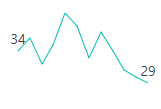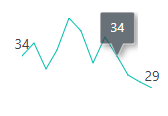Getting Started with Blazor Sparkline Component
10 Sep 202510 minutes to read
This section briefly explains about how to include Blazor Sparkline component in your Blazor WebAssembly App using Visual Studio and Visual Studio Code.
To get started quickly with Blazor Sparkline component, check on the following video:
Prerequisites
Create a new Blazor App in Visual Studio
You can create a Blazor WebAssembly App using Visual Studio via Microsoft Templates or the Syncfusion® Blazor Extension.
Install Syncfusion® Blazor Sparkline NuGet in the App
To add Blazor Sparkline component in the app, open the NuGet package manager in Visual Studio (Tools → NuGet Package Manager → Manage NuGet Packages for Solution), search and install Syncfusion.Blazor.Sparkline. Alternatively, you can utilize the following package manager command to achieve the same.
Install-Package Syncfusion.Blazor.Sparkline -Version 31.2.12NOTE
Syncfusion® Blazor components are available in nuget.org. Refer to NuGet packages topic for available NuGet packages list with component details.
Prerequisites
Create a new Blazor App in Visual Studio Code
You can create a Blazor WebAssembly App using Visual Studio Code via Microsoft Templates or the Syncfusion® Blazor Extension.
Alternatively, you can create a WebAssembly application using the following command in the terminal(Ctrl+`).
dotnet new blazorwasm -o BlazorApp
cd BlazorAppInstall Syncfusion® Blazor Sparkline NuGet in the App
- Press Ctrl+` to open the integrated terminal in Visual Studio Code.
- Ensure you’re in the project root directory where your
.csprojfile is located. - Run the following command to install a Syncfusion.Blazor.Sparkline NuGet package and ensure all dependencies are installed.
dotnet add package Syncfusion.Blazor.Sparkline -v 31.2.12
dotnet restoreNOTE
Syncfusion® Blazor components are available in nuget.org. Refer to NuGet packages topic for available NuGet packages list with component details.
Register Syncfusion® Blazor Service
Open ~/_Imports.razor file and import the Syncfusion.Blazor and Syncfusion.Blazor.Charts namespace.
@using Syncfusion.Blazor
@using Syncfusion.Blazor.ChartsNow, register the Syncfusion® Blazor Service in the ~/Program.cs file of your Blazor WebAssembly App.
using Microsoft.AspNetCore.Components.Web;
using Microsoft.AspNetCore.Components.WebAssembly.Hosting;
using Syncfusion.Blazor;
var builder = WebAssemblyHostBuilder.CreateDefault(args);
builder.RootComponents.Add<App>("#app");
builder.RootComponents.Add<HeadOutlet>("head::after");
builder.Services.AddScoped(sp => new HttpClient { BaseAddress = new Uri(builder.HostEnvironment.BaseAddress) });
builder.Services.AddSyncfusionBlazor();
await builder.Build().RunAsync();
....Add script resources
The script can be accessed from NuGet through Static Web Assets. Include the script reference in the <head> section of the ~/index.html file.
<head>
....
<script src="_content/Syncfusion.Blazor.Core/scripts/syncfusion-blazor.min.js" type="text/javascript"></script>
</head>NOTE
Check out the Adding Script Reference topic to learn different approaches for adding script references in your Blazor application.
Add Blazor Sparkline Component
Add the Syncfusion® Blazor Sparkline component in the ~/Pages/Index.razor file.
<SfSparkline>
</SfSparkline>Populate Blazor Sparkline with Data
To bind data for the Sparkline component, assign a IEnumerable object to the DataSource property. It can also be provided as an instance of the DataManager.
@code {
public class WeatherReport
{
public string Month { get; set; }
public double Celsius { get; set; }
};
public List<WeatherReport> ClimateData = new List<WeatherReport> {
new WeatherReport { Month= "Jan", Celsius= 34 },
new WeatherReport { Month= "Feb", Celsius= 36 },
new WeatherReport { Month= "Mar", Celsius= 32 },
new WeatherReport { Month= "Apr", Celsius= 35 },
new WeatherReport { Month= "May", Celsius= 40 },
new WeatherReport { Month= "Jun", Celsius= 38 },
new WeatherReport { Month= "Jul", Celsius= 33 },
new WeatherReport { Month= "Aug", Celsius= 37 },
new WeatherReport { Month= "Sep", Celsius= 34 },
new WeatherReport { Month= "Oct", Celsius= 31 },
new WeatherReport { Month= "Nov", Celsius= 30 },
new WeatherReport { Month= "Dec", Celsius= 29}
};
}Now map the Month and the Celsius fields from the datasource to XName and YName properties for x-axis and y-axis in the Sparkline and then set the ClimateData to DataSource property. Because the Month field is a value-based category, the ValueType property is used to specify it.
<SfSparkline XName="Month"
YName="Celsius"
ValueType="SparklineValueType.Category"
TValue="WeatherReport"
DataSource="ClimateData"
Height="80px"
Width="150px">
</SfSparkline>Press Ctrl+F5 (Windows) or ⌘+F5 (macOS) to launch the application. This will render the Syncfusion® Blazor Sparkline component in your default web browser.

Blazor Sparkline chart types
Change the Sparkline type using the Type property set to Line, Column, WinLoss, Pie or Area. Here, the Sparkline type is set to Area.
<SfSparkline XName="Month"
YName="Celsius"
ValueType="SparklineValueType.Category"
Type="SparklineType.Area"
TValue="WeatherReport"
DataSource="ClimateData"
Height="80px"
Width="150px">
</SfSparkline>
NOTE
Refer to code block to know about the property value of ClimateData.
Adding Data Label
Add the Data Labels to improve the readability of the Sparkline component. This can be achieved by setting the Visible property to true in the SparklineDataLabelSettings.
Available types are:
- Start
- End
- All
- High
- Low
- Negative
<SfSparkline DataSource="ClimateData"
TValue="WeatherReport"
XName="Month"
YName="Celsius"
ValueType="SparklineValueType.Category"
Height="80px"
Width="150px">
<SparklineDataLabelSettings Visible="new List<VisibleType> { VisibleType.Start, VisibleType.End }"></SparklineDataLabelSettings>
<SparklinePadding Left="10" Right="10"></SparklinePadding>
</SfSparkline>NOTE
Refer to the code block to know about the property value of ClimateData.

Enable tooltip
When space constraints prevent from displaying information using Data Labels, the tooltip comes in handy. The tooltip can be enabled by setting the Visible property to true in the SparklineTooltipSettings.
<SfSparkline DataSource="ClimateData"
TValue="WeatherReport"
XName="Month"
YName="Celsius"
ValueType="SparklineValueType.Category"
Height="80px"
Width="150px">
<SparklineDataLabelSettings Visible="new List<VisibleType> { VisibleType.Start, VisibleType.End }"></SparklineDataLabelSettings>
<SparklinePadding Left="10" Right="10"></SparklinePadding>
<SparklineTooltipSettings TValue="WeatherReport" Visible="true"></SparklineTooltipSettings>
</SfSparkline>NOTE
Refer to the code block to know about the property value of the ClimateData.

NOTE
See also
-
Getting Started with Syncfusion® Blazor for Client-Side in .NET Core CLI
-
Getting Started with Syncfusion® Blazor for Server-Side in Visual Studio
-
Getting Started with Syncfusion® Blazor for Server-Side in .NET Core CLI
NOTE
You can also explore our Blazor Sparkline Chart example that shows you how to render and configure the sparkline chart.